A Project on Talent Management Strategies Followed by Lloyds Bank
VerifiedAdded on 2023/06/18
|25
|5068
|499
Report
AI Summary
This report provides an analysis of the talent management strategies employed by Lloyds Bank to retain and attract a talented workforce. It begins with project planning, outlining research aims, objectives, and questions. The report details the research methodology, including the chosen research philosophy (positivism), approach (deductive), and strategy (survey). Primary and secondary data collection methods are described, along with ethical considerations. Secondary research explores the basics of talent management and specific strategies used by Lloyds Bank, such as offering benefits and opportunities for development. The report aims to offer insights into effective talent management practices within a large organization. Desklib offers a variety of study tools and solved assignments for students.

MANAGING A
SUCCESSFUL BUSINESS
PROJECT
SUCCESSFUL BUSINESS
PROJECT
Paraphrase This Document
Need a fresh take? Get an instant paraphrase of this document with our AI Paraphraser
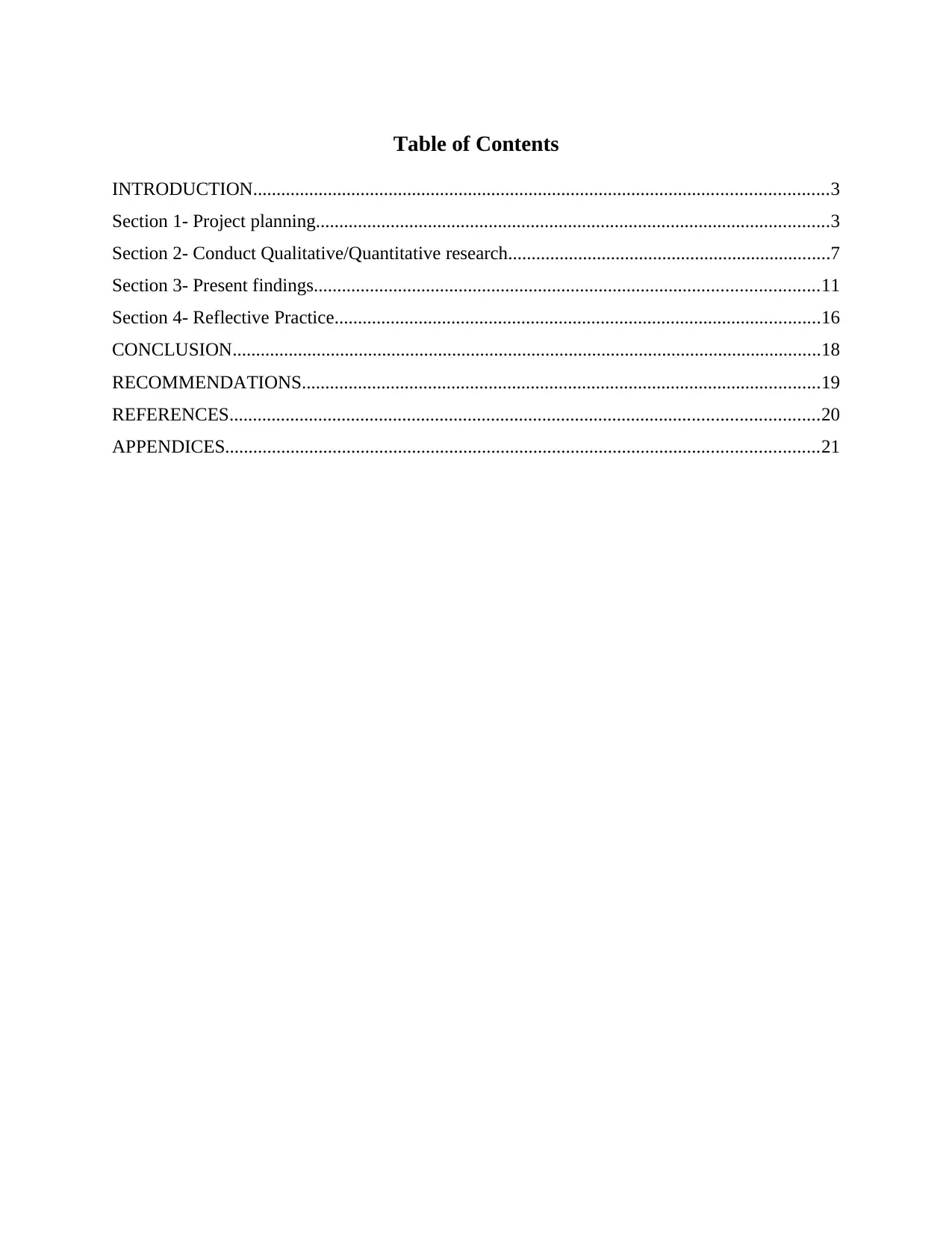
Table of Contents
INTRODUCTION...........................................................................................................................3
Section 1- Project planning..............................................................................................................3
Section 2- Conduct Qualitative/Quantitative research.....................................................................7
Section 3- Present findings............................................................................................................11
Section 4- Reflective Practice........................................................................................................16
CONCLUSION..............................................................................................................................18
RECOMMENDATIONS...............................................................................................................19
REFERENCES..............................................................................................................................20
APPENDICES...............................................................................................................................21
INTRODUCTION...........................................................................................................................3
Section 1- Project planning..............................................................................................................3
Section 2- Conduct Qualitative/Quantitative research.....................................................................7
Section 3- Present findings............................................................................................................11
Section 4- Reflective Practice........................................................................................................16
CONCLUSION..............................................................................................................................18
RECOMMENDATIONS...............................................................................................................19
REFERENCES..............................................................................................................................20
APPENDICES...............................................................................................................................21
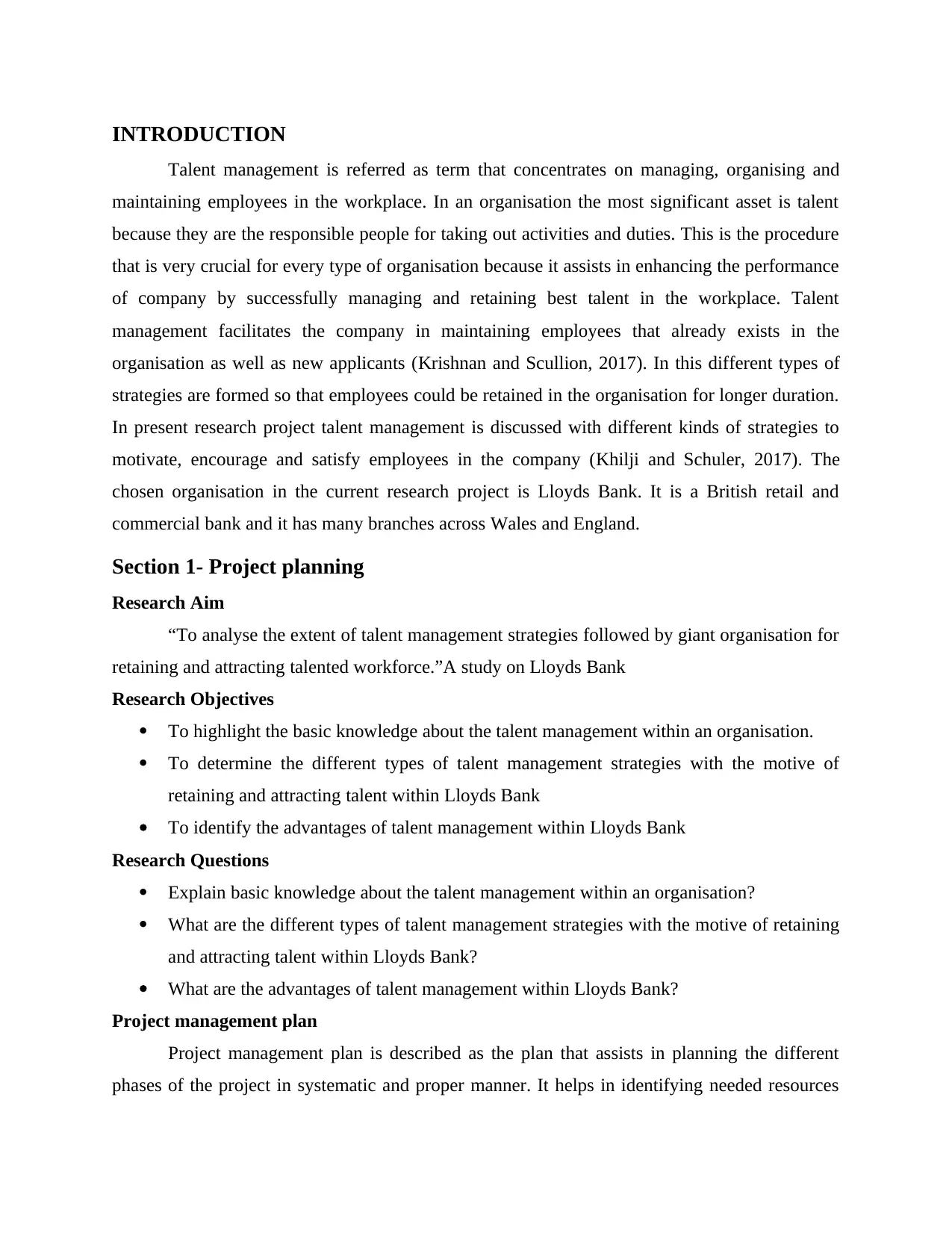
INTRODUCTION
Talent management is referred as term that concentrates on managing, organising and
maintaining employees in the workplace. In an organisation the most significant asset is talent
because they are the responsible people for taking out activities and duties. This is the procedure
that is very crucial for every type of organisation because it assists in enhancing the performance
of company by successfully managing and retaining best talent in the workplace. Talent
management facilitates the company in maintaining employees that already exists in the
organisation as well as new applicants (Krishnan and Scullion, 2017). In this different types of
strategies are formed so that employees could be retained in the organisation for longer duration.
In present research project talent management is discussed with different kinds of strategies to
motivate, encourage and satisfy employees in the company (Khilji and Schuler, 2017). The
chosen organisation in the current research project is Lloyds Bank. It is a British retail and
commercial bank and it has many branches across Wales and England.
Section 1- Project planning
Research Aim
“To analyse the extent of talent management strategies followed by giant organisation for
retaining and attracting talented workforce.”A study on Lloyds Bank
Research Objectives
To highlight the basic knowledge about the talent management within an organisation.
To determine the different types of talent management strategies with the motive of
retaining and attracting talent within Lloyds Bank
To identify the advantages of talent management within Lloyds Bank
Research Questions
Explain basic knowledge about the talent management within an organisation?
What are the different types of talent management strategies with the motive of retaining
and attracting talent within Lloyds Bank?
What are the advantages of talent management within Lloyds Bank?
Project management plan
Project management plan is described as the plan that assists in planning the different
phases of the project in systematic and proper manner. It helps in identifying needed resources
Talent management is referred as term that concentrates on managing, organising and
maintaining employees in the workplace. In an organisation the most significant asset is talent
because they are the responsible people for taking out activities and duties. This is the procedure
that is very crucial for every type of organisation because it assists in enhancing the performance
of company by successfully managing and retaining best talent in the workplace. Talent
management facilitates the company in maintaining employees that already exists in the
organisation as well as new applicants (Krishnan and Scullion, 2017). In this different types of
strategies are formed so that employees could be retained in the organisation for longer duration.
In present research project talent management is discussed with different kinds of strategies to
motivate, encourage and satisfy employees in the company (Khilji and Schuler, 2017). The
chosen organisation in the current research project is Lloyds Bank. It is a British retail and
commercial bank and it has many branches across Wales and England.
Section 1- Project planning
Research Aim
“To analyse the extent of talent management strategies followed by giant organisation for
retaining and attracting talented workforce.”A study on Lloyds Bank
Research Objectives
To highlight the basic knowledge about the talent management within an organisation.
To determine the different types of talent management strategies with the motive of
retaining and attracting talent within Lloyds Bank
To identify the advantages of talent management within Lloyds Bank
Research Questions
Explain basic knowledge about the talent management within an organisation?
What are the different types of talent management strategies with the motive of retaining
and attracting talent within Lloyds Bank?
What are the advantages of talent management within Lloyds Bank?
Project management plan
Project management plan is described as the plan that assists in planning the different
phases of the project in systematic and proper manner. It helps in identifying needed resources
⊘ This is a preview!⊘
Do you want full access?
Subscribe today to unlock all pages.

Trusted by 1+ million students worldwide
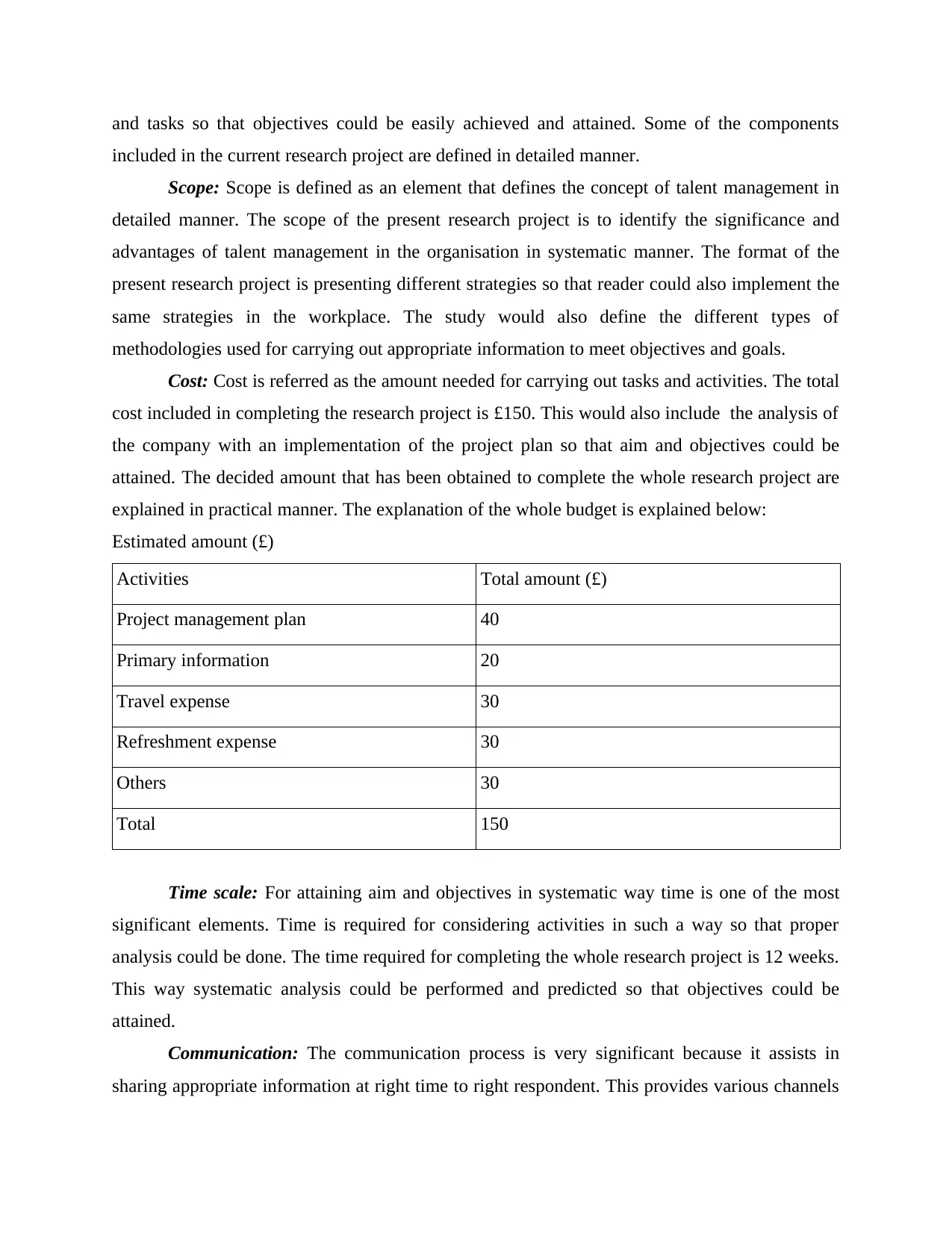
and tasks so that objectives could be easily achieved and attained. Some of the components
included in the current research project are defined in detailed manner.
Scope: Scope is defined as an element that defines the concept of talent management in
detailed manner. The scope of the present research project is to identify the significance and
advantages of talent management in the organisation in systematic manner. The format of the
present research project is presenting different strategies so that reader could also implement the
same strategies in the workplace. The study would also define the different types of
methodologies used for carrying out appropriate information to meet objectives and goals.
Cost: Cost is referred as the amount needed for carrying out tasks and activities. The total
cost included in completing the research project is £150. This would also include the analysis of
the company with an implementation of the project plan so that aim and objectives could be
attained. The decided amount that has been obtained to complete the whole research project are
explained in practical manner. The explanation of the whole budget is explained below:
Estimated amount (£)
Activities Total amount (£)
Project management plan 40
Primary information 20
Travel expense 30
Refreshment expense 30
Others 30
Total 150
Time scale: For attaining aim and objectives in systematic way time is one of the most
significant elements. Time is required for considering activities in such a way so that proper
analysis could be done. The time required for completing the whole research project is 12 weeks.
This way systematic analysis could be performed and predicted so that objectives could be
attained.
Communication: The communication process is very significant because it assists in
sharing appropriate information at right time to right respondent. This provides various channels
included in the current research project are defined in detailed manner.
Scope: Scope is defined as an element that defines the concept of talent management in
detailed manner. The scope of the present research project is to identify the significance and
advantages of talent management in the organisation in systematic manner. The format of the
present research project is presenting different strategies so that reader could also implement the
same strategies in the workplace. The study would also define the different types of
methodologies used for carrying out appropriate information to meet objectives and goals.
Cost: Cost is referred as the amount needed for carrying out tasks and activities. The total
cost included in completing the research project is £150. This would also include the analysis of
the company with an implementation of the project plan so that aim and objectives could be
attained. The decided amount that has been obtained to complete the whole research project are
explained in practical manner. The explanation of the whole budget is explained below:
Estimated amount (£)
Activities Total amount (£)
Project management plan 40
Primary information 20
Travel expense 30
Refreshment expense 30
Others 30
Total 150
Time scale: For attaining aim and objectives in systematic way time is one of the most
significant elements. Time is required for considering activities in such a way so that proper
analysis could be done. The time required for completing the whole research project is 12 weeks.
This way systematic analysis could be performed and predicted so that objectives could be
attained.
Communication: The communication process is very significant because it assists in
sharing appropriate information at right time to right respondent. This provides various channels
Paraphrase This Document
Need a fresh take? Get an instant paraphrase of this document with our AI Paraphraser
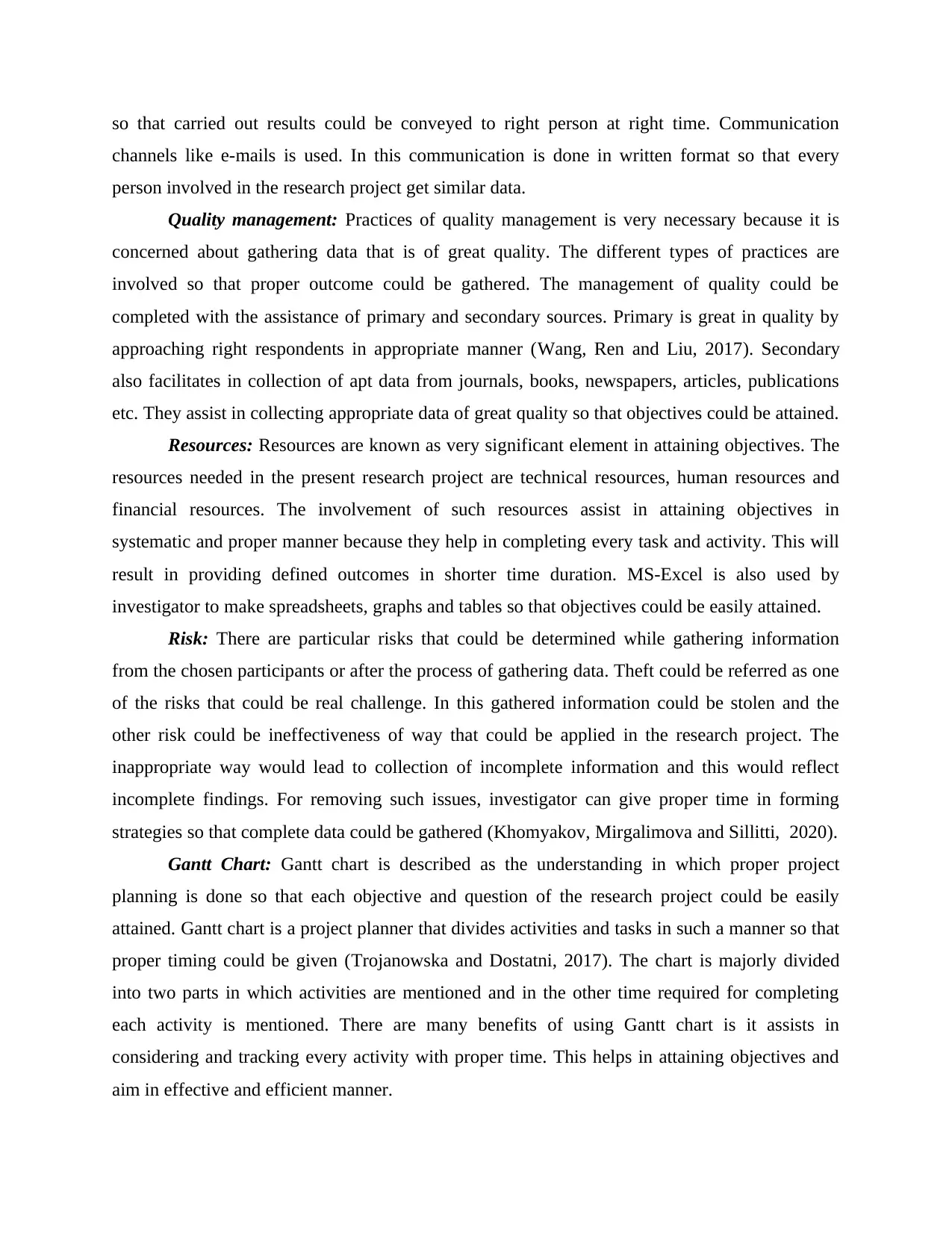
so that carried out results could be conveyed to right person at right time. Communication
channels like e-mails is used. In this communication is done in written format so that every
person involved in the research project get similar data.
Quality management: Practices of quality management is very necessary because it is
concerned about gathering data that is of great quality. The different types of practices are
involved so that proper outcome could be gathered. The management of quality could be
completed with the assistance of primary and secondary sources. Primary is great in quality by
approaching right respondents in appropriate manner (Wang, Ren and Liu, 2017). Secondary
also facilitates in collection of apt data from journals, books, newspapers, articles, publications
etc. They assist in collecting appropriate data of great quality so that objectives could be attained.
Resources: Resources are known as very significant element in attaining objectives. The
resources needed in the present research project are technical resources, human resources and
financial resources. The involvement of such resources assist in attaining objectives in
systematic and proper manner because they help in completing every task and activity. This will
result in providing defined outcomes in shorter time duration. MS-Excel is also used by
investigator to make spreadsheets, graphs and tables so that objectives could be easily attained.
Risk: There are particular risks that could be determined while gathering information
from the chosen participants or after the process of gathering data. Theft could be referred as one
of the risks that could be real challenge. In this gathered information could be stolen and the
other risk could be ineffectiveness of way that could be applied in the research project. The
inappropriate way would lead to collection of incomplete information and this would reflect
incomplete findings. For removing such issues, investigator can give proper time in forming
strategies so that complete data could be gathered (Khomyakov, Mirgalimova and Sillitti, 2020).
Gantt Chart: Gantt chart is described as the understanding in which proper project
planning is done so that each objective and question of the research project could be easily
attained. Gantt chart is a project planner that divides activities and tasks in such a manner so that
proper timing could be given (Trojanowska and Dostatni, 2017). The chart is majorly divided
into two parts in which activities are mentioned and in the other time required for completing
each activity is mentioned. There are many benefits of using Gantt chart is it assists in
considering and tracking every activity with proper time. This helps in attaining objectives and
aim in effective and efficient manner.
channels like e-mails is used. In this communication is done in written format so that every
person involved in the research project get similar data.
Quality management: Practices of quality management is very necessary because it is
concerned about gathering data that is of great quality. The different types of practices are
involved so that proper outcome could be gathered. The management of quality could be
completed with the assistance of primary and secondary sources. Primary is great in quality by
approaching right respondents in appropriate manner (Wang, Ren and Liu, 2017). Secondary
also facilitates in collection of apt data from journals, books, newspapers, articles, publications
etc. They assist in collecting appropriate data of great quality so that objectives could be attained.
Resources: Resources are known as very significant element in attaining objectives. The
resources needed in the present research project are technical resources, human resources and
financial resources. The involvement of such resources assist in attaining objectives in
systematic and proper manner because they help in completing every task and activity. This will
result in providing defined outcomes in shorter time duration. MS-Excel is also used by
investigator to make spreadsheets, graphs and tables so that objectives could be easily attained.
Risk: There are particular risks that could be determined while gathering information
from the chosen participants or after the process of gathering data. Theft could be referred as one
of the risks that could be real challenge. In this gathered information could be stolen and the
other risk could be ineffectiveness of way that could be applied in the research project. The
inappropriate way would lead to collection of incomplete information and this would reflect
incomplete findings. For removing such issues, investigator can give proper time in forming
strategies so that complete data could be gathered (Khomyakov, Mirgalimova and Sillitti, 2020).
Gantt Chart: Gantt chart is described as the understanding in which proper project
planning is done so that each objective and question of the research project could be easily
attained. Gantt chart is a project planner that divides activities and tasks in such a manner so that
proper timing could be given (Trojanowska and Dostatni, 2017). The chart is majorly divided
into two parts in which activities are mentioned and in the other time required for completing
each activity is mentioned. There are many benefits of using Gantt chart is it assists in
considering and tracking every activity with proper time. This helps in attaining objectives and
aim in effective and efficient manner.
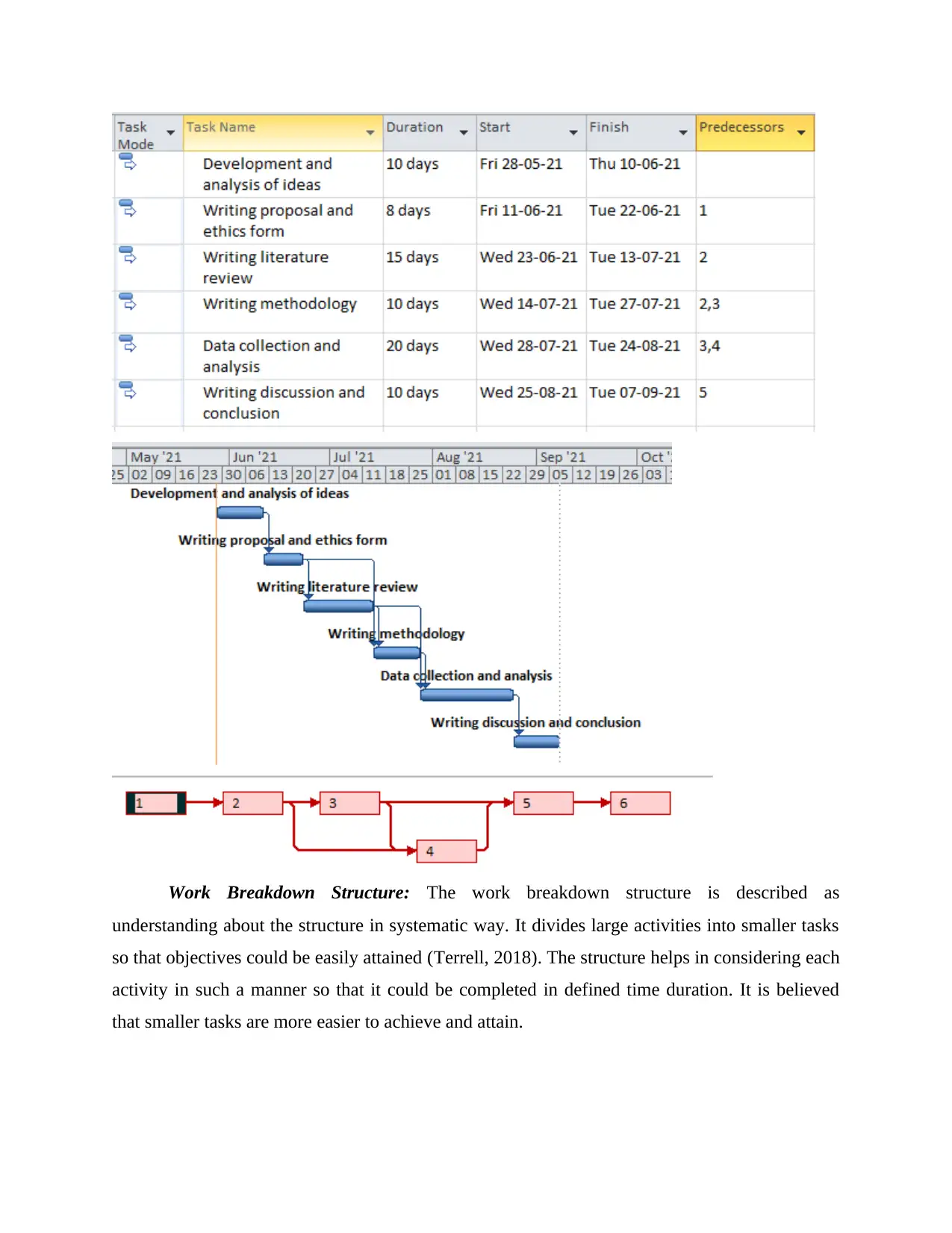
Work Breakdown Structure: The work breakdown structure is described as
understanding about the structure in systematic way. It divides large activities into smaller tasks
so that objectives could be easily attained (Terrell, 2018). The structure helps in considering each
activity in such a manner so that it could be completed in defined time duration. It is believed
that smaller tasks are more easier to achieve and attain.
understanding about the structure in systematic way. It divides large activities into smaller tasks
so that objectives could be easily attained (Terrell, 2018). The structure helps in considering each
activity in such a manner so that it could be completed in defined time duration. It is believed
that smaller tasks are more easier to achieve and attain.
⊘ This is a preview!⊘
Do you want full access?
Subscribe today to unlock all pages.

Trusted by 1+ million students worldwide
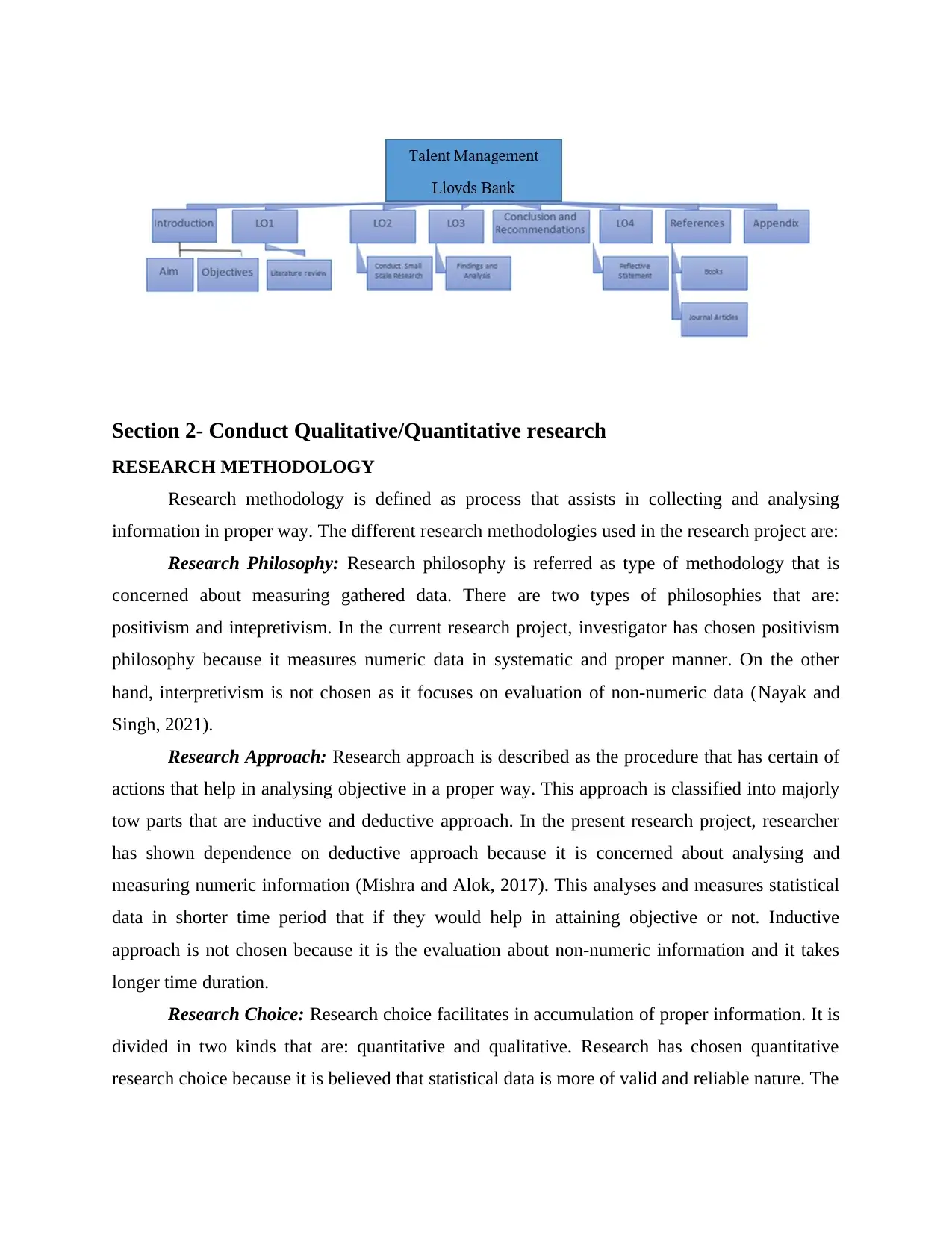
Section 2- Conduct Qualitative/Quantitative research
RESEARCH METHODOLOGY
Research methodology is defined as process that assists in collecting and analysing
information in proper way. The different research methodologies used in the research project are:
Research Philosophy: Research philosophy is referred as type of methodology that is
concerned about measuring gathered data. There are two types of philosophies that are:
positivism and intepretivism. In the current research project, investigator has chosen positivism
philosophy because it measures numeric data in systematic and proper manner. On the other
hand, interpretivism is not chosen as it focuses on evaluation of non-numeric data (Nayak and
Singh, 2021).
Research Approach: Research approach is described as the procedure that has certain of
actions that help in analysing objective in a proper way. This approach is classified into majorly
tow parts that are inductive and deductive approach. In the present research project, researcher
has shown dependence on deductive approach because it is concerned about analysing and
measuring numeric information (Mishra and Alok, 2017). This analyses and measures statistical
data in shorter time period that if they would help in attaining objective or not. Inductive
approach is not chosen because it is the evaluation about non-numeric information and it takes
longer time duration.
Research Choice: Research choice facilitates in accumulation of proper information. It is
divided in two kinds that are: quantitative and qualitative. Research has chosen quantitative
research choice because it is believed that statistical data is more of valid and reliable nature. The
RESEARCH METHODOLOGY
Research methodology is defined as process that assists in collecting and analysing
information in proper way. The different research methodologies used in the research project are:
Research Philosophy: Research philosophy is referred as type of methodology that is
concerned about measuring gathered data. There are two types of philosophies that are:
positivism and intepretivism. In the current research project, investigator has chosen positivism
philosophy because it measures numeric data in systematic and proper manner. On the other
hand, interpretivism is not chosen as it focuses on evaluation of non-numeric data (Nayak and
Singh, 2021).
Research Approach: Research approach is described as the procedure that has certain of
actions that help in analysing objective in a proper way. This approach is classified into majorly
tow parts that are inductive and deductive approach. In the present research project, researcher
has shown dependence on deductive approach because it is concerned about analysing and
measuring numeric information (Mishra and Alok, 2017). This analyses and measures statistical
data in shorter time period that if they would help in attaining objective or not. Inductive
approach is not chosen because it is the evaluation about non-numeric information and it takes
longer time duration.
Research Choice: Research choice facilitates in accumulation of proper information. It is
divided in two kinds that are: quantitative and qualitative. Research has chosen quantitative
research choice because it is believed that statistical data is more of valid and reliable nature. The
Paraphrase This Document
Need a fresh take? Get an instant paraphrase of this document with our AI Paraphraser

quantitative data could be collected easily in short time so that objectives could be easily met.
Qualitative is not chosen because it is about gathering text and theory data (Ragab and Arisha,
2018). It is believed that the collection of this type of data is long process and it is time
consuming process.
Research Strategy: Research strategy is about the process of collecting information.
There are different types of research strategy that are: survey, action research, case study,
experimental research, grounded theory etc. Investigator has chosen survey strategy because it is
about collection of primary information. Survey is great strategy because it helps in collecting
data directly from the information provider (Abutabenjeh and Jaradat, 2018). In survey
questionnaire is made in which close ended questions are included.
Data Collection: Data collection is described as the procedure of accumulating
information from two types that are secondary and primary. The researcher has chosen primary
and secondary. With the help of primary, researcher has tried to take out raw data from selected
representatives and for this questionnaire is made (Daniel, Kumar and Omar, 2018). The
secondary data collection has assisted in gathering data that is already available because it had
been already taken out by other person for different motive. Books, articles, newspapers,
journals, publications, blogs by different authors etc.
Sampling: Sampling is referred as the methodology that is about selecting certain number
of respondents from the large population. It is needed because it helps in selecting
representatives who can represent the whole population. Probability and non-probability are two
kinds of sampling. In the present research, investigator has chosen probability sampling because
it assists in selecting respondents randomly. It does not specify certain criteria before choosing
participants. Non-probability is not chosen because it selects respondents non-randomly
(Worthington and Bodie, 2017). 20 participants are selected randomly from the chosen
organisation.
Ethical Consideration: In the procedure of conducting research project, investigator has
aimed at carrying out activities in an ethical way. Investigator has taken consent from the chosen
organisation before collecting any data about the related topic. The researcher has also focused
on not harming the chosen respondents physically or mentally.
SECONDARY RESEARCH
Explain basic knowledge about the talent management within an organisation?
Qualitative is not chosen because it is about gathering text and theory data (Ragab and Arisha,
2018). It is believed that the collection of this type of data is long process and it is time
consuming process.
Research Strategy: Research strategy is about the process of collecting information.
There are different types of research strategy that are: survey, action research, case study,
experimental research, grounded theory etc. Investigator has chosen survey strategy because it is
about collection of primary information. Survey is great strategy because it helps in collecting
data directly from the information provider (Abutabenjeh and Jaradat, 2018). In survey
questionnaire is made in which close ended questions are included.
Data Collection: Data collection is described as the procedure of accumulating
information from two types that are secondary and primary. The researcher has chosen primary
and secondary. With the help of primary, researcher has tried to take out raw data from selected
representatives and for this questionnaire is made (Daniel, Kumar and Omar, 2018). The
secondary data collection has assisted in gathering data that is already available because it had
been already taken out by other person for different motive. Books, articles, newspapers,
journals, publications, blogs by different authors etc.
Sampling: Sampling is referred as the methodology that is about selecting certain number
of respondents from the large population. It is needed because it helps in selecting
representatives who can represent the whole population. Probability and non-probability are two
kinds of sampling. In the present research, investigator has chosen probability sampling because
it assists in selecting respondents randomly. It does not specify certain criteria before choosing
participants. Non-probability is not chosen because it selects respondents non-randomly
(Worthington and Bodie, 2017). 20 participants are selected randomly from the chosen
organisation.
Ethical Consideration: In the procedure of conducting research project, investigator has
aimed at carrying out activities in an ethical way. Investigator has taken consent from the chosen
organisation before collecting any data about the related topic. The researcher has also focused
on not harming the chosen respondents physically or mentally.
SECONDARY RESEARCH
Explain basic knowledge about the talent management within an organisation?
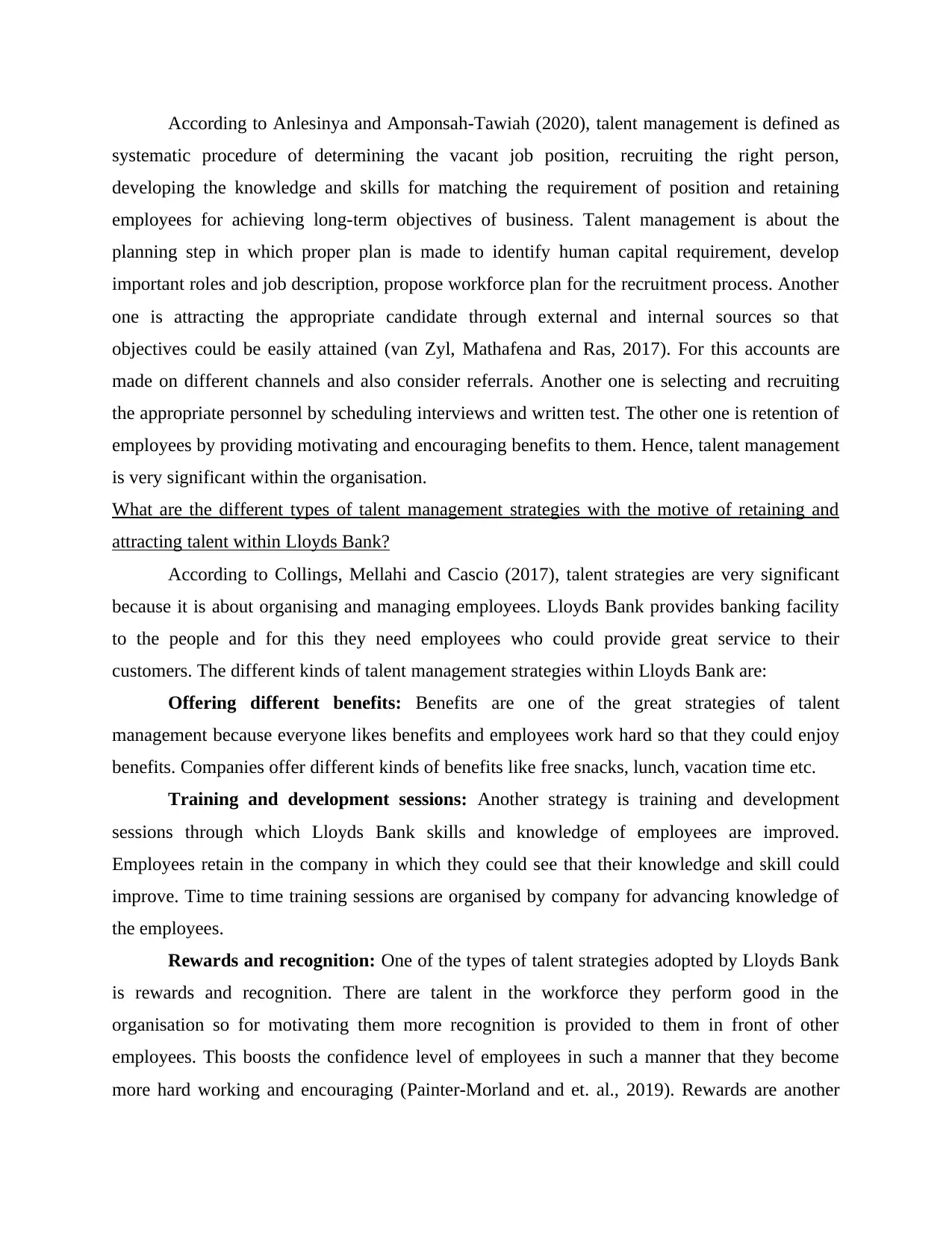
According to Anlesinya and Amponsah-Tawiah (2020), talent management is defined as
systematic procedure of determining the vacant job position, recruiting the right person,
developing the knowledge and skills for matching the requirement of position and retaining
employees for achieving long-term objectives of business. Talent management is about the
planning step in which proper plan is made to identify human capital requirement, develop
important roles and job description, propose workforce plan for the recruitment process. Another
one is attracting the appropriate candidate through external and internal sources so that
objectives could be easily attained (van Zyl, Mathafena and Ras, 2017). For this accounts are
made on different channels and also consider referrals. Another one is selecting and recruiting
the appropriate personnel by scheduling interviews and written test. The other one is retention of
employees by providing motivating and encouraging benefits to them. Hence, talent management
is very significant within the organisation.
What are the different types of talent management strategies with the motive of retaining and
attracting talent within Lloyds Bank?
According to Collings, Mellahi and Cascio (2017), talent strategies are very significant
because it is about organising and managing employees. Lloyds Bank provides banking facility
to the people and for this they need employees who could provide great service to their
customers. The different kinds of talent management strategies within Lloyds Bank are:
Offering different benefits: Benefits are one of the great strategies of talent
management because everyone likes benefits and employees work hard so that they could enjoy
benefits. Companies offer different kinds of benefits like free snacks, lunch, vacation time etc.
Training and development sessions: Another strategy is training and development
sessions through which Lloyds Bank skills and knowledge of employees are improved.
Employees retain in the company in which they could see that their knowledge and skill could
improve. Time to time training sessions are organised by company for advancing knowledge of
the employees.
Rewards and recognition: One of the types of talent strategies adopted by Lloyds Bank
is rewards and recognition. There are talent in the workforce they perform good in the
organisation so for motivating them more recognition is provided to them in front of other
employees. This boosts the confidence level of employees in such a manner that they become
more hard working and encouraging (Painter‐Morland and et. al., 2019). Rewards are another
systematic procedure of determining the vacant job position, recruiting the right person,
developing the knowledge and skills for matching the requirement of position and retaining
employees for achieving long-term objectives of business. Talent management is about the
planning step in which proper plan is made to identify human capital requirement, develop
important roles and job description, propose workforce plan for the recruitment process. Another
one is attracting the appropriate candidate through external and internal sources so that
objectives could be easily attained (van Zyl, Mathafena and Ras, 2017). For this accounts are
made on different channels and also consider referrals. Another one is selecting and recruiting
the appropriate personnel by scheduling interviews and written test. The other one is retention of
employees by providing motivating and encouraging benefits to them. Hence, talent management
is very significant within the organisation.
What are the different types of talent management strategies with the motive of retaining and
attracting talent within Lloyds Bank?
According to Collings, Mellahi and Cascio (2017), talent strategies are very significant
because it is about organising and managing employees. Lloyds Bank provides banking facility
to the people and for this they need employees who could provide great service to their
customers. The different kinds of talent management strategies within Lloyds Bank are:
Offering different benefits: Benefits are one of the great strategies of talent
management because everyone likes benefits and employees work hard so that they could enjoy
benefits. Companies offer different kinds of benefits like free snacks, lunch, vacation time etc.
Training and development sessions: Another strategy is training and development
sessions through which Lloyds Bank skills and knowledge of employees are improved.
Employees retain in the company in which they could see that their knowledge and skill could
improve. Time to time training sessions are organised by company for advancing knowledge of
the employees.
Rewards and recognition: One of the types of talent strategies adopted by Lloyds Bank
is rewards and recognition. There are talent in the workforce they perform good in the
organisation so for motivating them more recognition is provided to them in front of other
employees. This boosts the confidence level of employees in such a manner that they become
more hard working and encouraging (Painter‐Morland and et. al., 2019). Rewards are another
⊘ This is a preview!⊘
Do you want full access?
Subscribe today to unlock all pages.

Trusted by 1+ million students worldwide
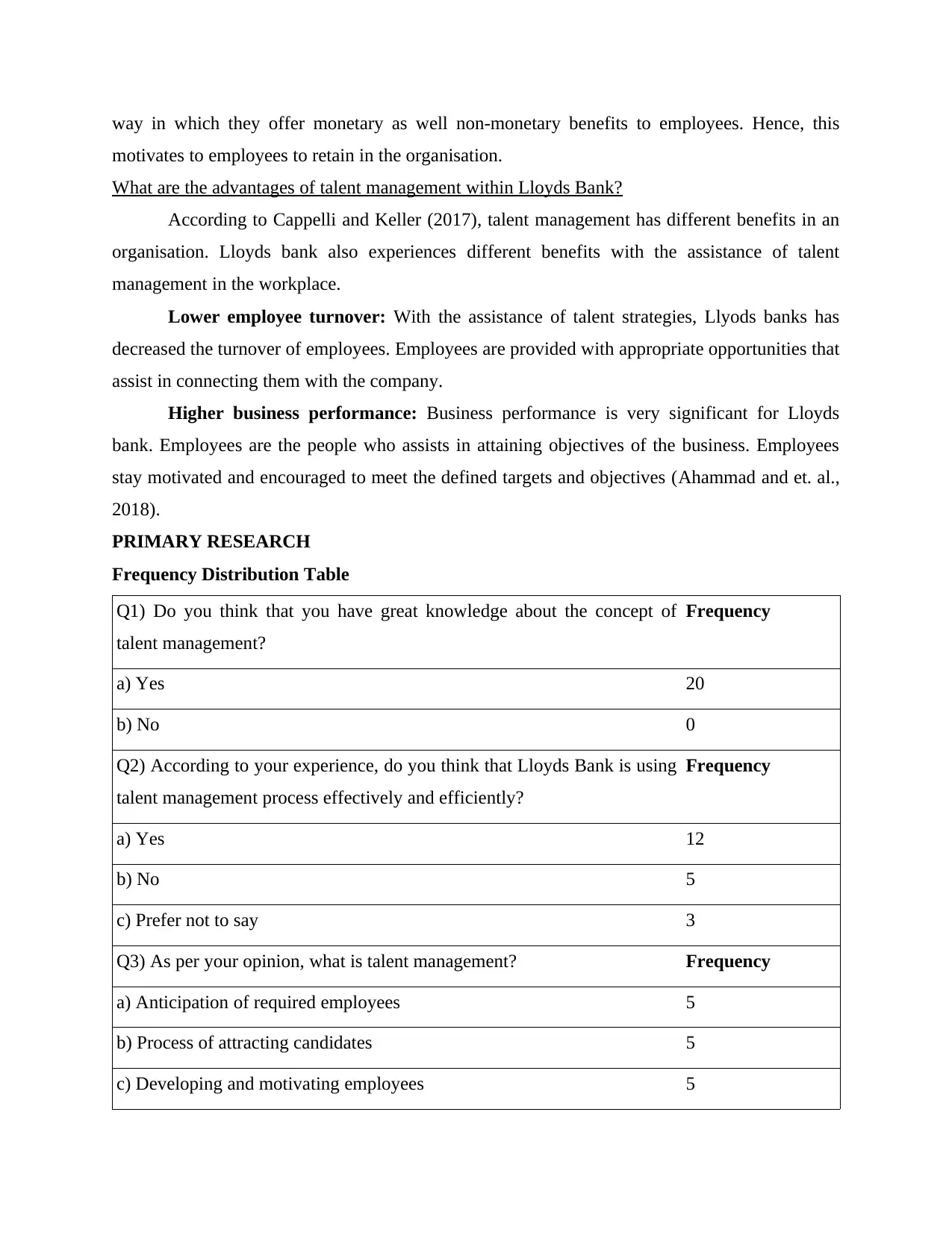
way in which they offer monetary as well non-monetary benefits to employees. Hence, this
motivates to employees to retain in the organisation.
What are the advantages of talent management within Lloyds Bank?
According to Cappelli and Keller (2017), talent management has different benefits in an
organisation. Lloyds bank also experiences different benefits with the assistance of talent
management in the workplace.
Lower employee turnover: With the assistance of talent strategies, Llyods banks has
decreased the turnover of employees. Employees are provided with appropriate opportunities that
assist in connecting them with the company.
Higher business performance: Business performance is very significant for Lloyds
bank. Employees are the people who assists in attaining objectives of the business. Employees
stay motivated and encouraged to meet the defined targets and objectives (Ahammad and et. al.,
2018).
PRIMARY RESEARCH
Frequency Distribution Table
Q1) Do you think that you have great knowledge about the concept of
talent management?
Frequency
a) Yes 20
b) No 0
Q2) According to your experience, do you think that Lloyds Bank is using
talent management process effectively and efficiently?
Frequency
a) Yes 12
b) No 5
c) Prefer not to say 3
Q3) As per your opinion, what is talent management? Frequency
a) Anticipation of required employees 5
b) Process of attracting candidates 5
c) Developing and motivating employees 5
motivates to employees to retain in the organisation.
What are the advantages of talent management within Lloyds Bank?
According to Cappelli and Keller (2017), talent management has different benefits in an
organisation. Lloyds bank also experiences different benefits with the assistance of talent
management in the workplace.
Lower employee turnover: With the assistance of talent strategies, Llyods banks has
decreased the turnover of employees. Employees are provided with appropriate opportunities that
assist in connecting them with the company.
Higher business performance: Business performance is very significant for Lloyds
bank. Employees are the people who assists in attaining objectives of the business. Employees
stay motivated and encouraged to meet the defined targets and objectives (Ahammad and et. al.,
2018).
PRIMARY RESEARCH
Frequency Distribution Table
Q1) Do you think that you have great knowledge about the concept of
talent management?
Frequency
a) Yes 20
b) No 0
Q2) According to your experience, do you think that Lloyds Bank is using
talent management process effectively and efficiently?
Frequency
a) Yes 12
b) No 5
c) Prefer not to say 3
Q3) As per your opinion, what is talent management? Frequency
a) Anticipation of required employees 5
b) Process of attracting candidates 5
c) Developing and motivating employees 5
Paraphrase This Document
Need a fresh take? Get an instant paraphrase of this document with our AI Paraphraser
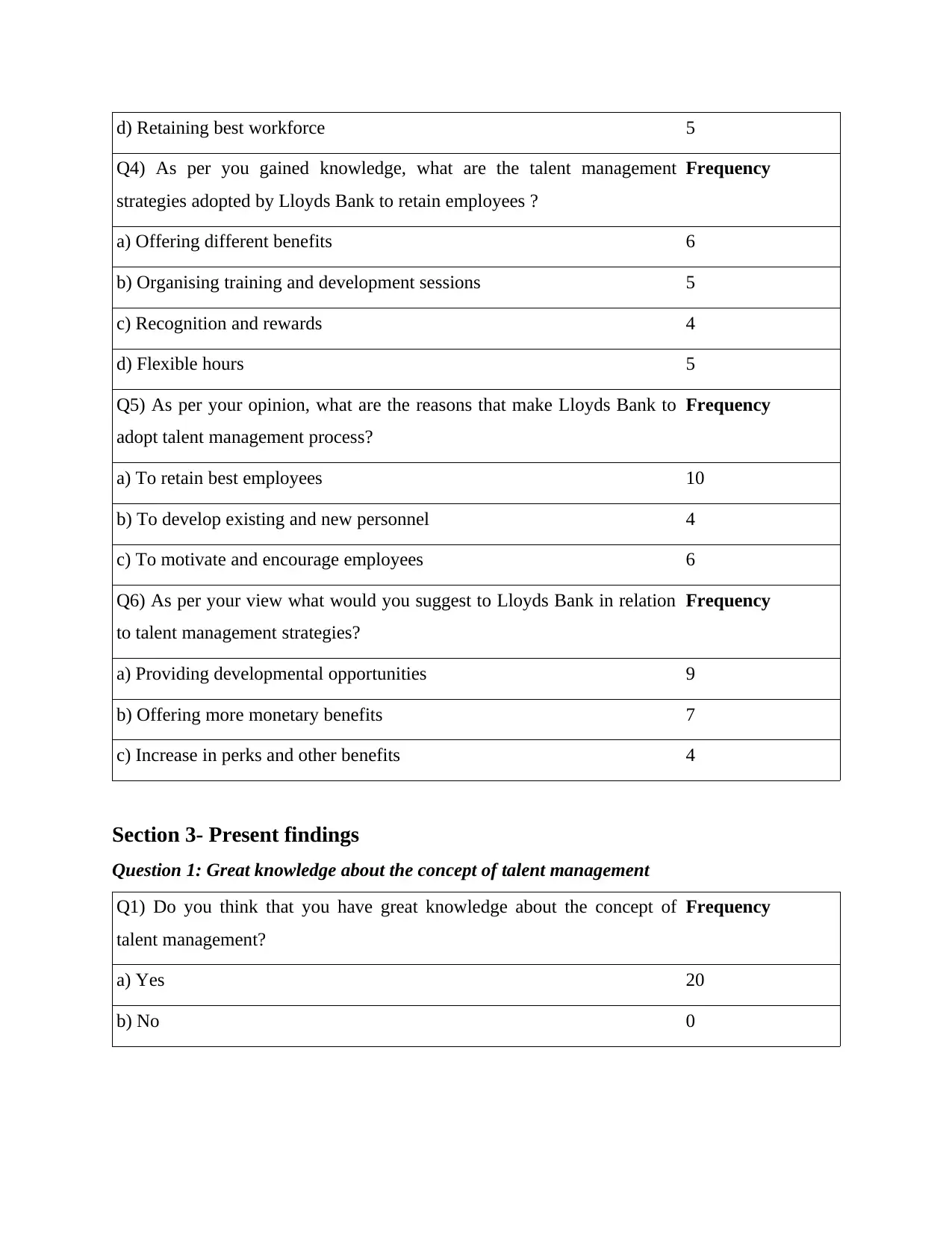
d) Retaining best workforce 5
Q4) As per you gained knowledge, what are the talent management
strategies adopted by Lloyds Bank to retain employees ?
Frequency
a) Offering different benefits 6
b) Organising training and development sessions 5
c) Recognition and rewards 4
d) Flexible hours 5
Q5) As per your opinion, what are the reasons that make Lloyds Bank to
adopt talent management process?
Frequency
a) To retain best employees 10
b) To develop existing and new personnel 4
c) To motivate and encourage employees 6
Q6) As per your view what would you suggest to Lloyds Bank in relation
to talent management strategies?
Frequency
a) Providing developmental opportunities 9
b) Offering more monetary benefits 7
c) Increase in perks and other benefits 4
Section 3- Present findings
Question 1: Great knowledge about the concept of talent management
Q1) Do you think that you have great knowledge about the concept of
talent management?
Frequency
a) Yes 20
b) No 0
Q4) As per you gained knowledge, what are the talent management
strategies adopted by Lloyds Bank to retain employees ?
Frequency
a) Offering different benefits 6
b) Organising training and development sessions 5
c) Recognition and rewards 4
d) Flexible hours 5
Q5) As per your opinion, what are the reasons that make Lloyds Bank to
adopt talent management process?
Frequency
a) To retain best employees 10
b) To develop existing and new personnel 4
c) To motivate and encourage employees 6
Q6) As per your view what would you suggest to Lloyds Bank in relation
to talent management strategies?
Frequency
a) Providing developmental opportunities 9
b) Offering more monetary benefits 7
c) Increase in perks and other benefits 4
Section 3- Present findings
Question 1: Great knowledge about the concept of talent management
Q1) Do you think that you have great knowledge about the concept of
talent management?
Frequency
a) Yes 20
b) No 0
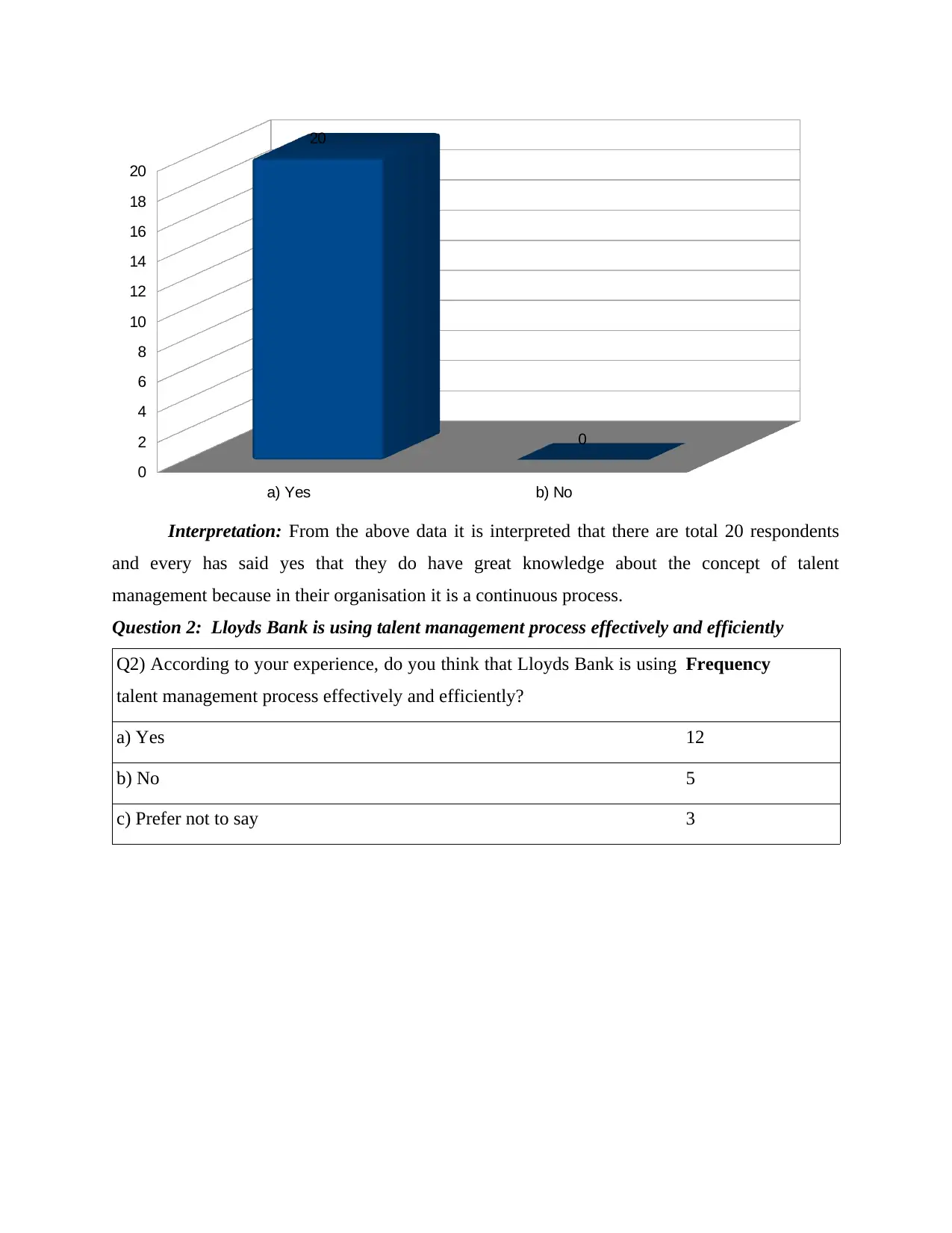
a) Yes b) No
0
2
4
6
8
10
12
14
16
18
20
20
0
Interpretation: From the above data it is interpreted that there are total 20 respondents
and every has said yes that they do have great knowledge about the concept of talent
management because in their organisation it is a continuous process.
Question 2: Lloyds Bank is using talent management process effectively and efficiently
Q2) According to your experience, do you think that Lloyds Bank is using
talent management process effectively and efficiently?
Frequency
a) Yes 12
b) No 5
c) Prefer not to say 3
0
2
4
6
8
10
12
14
16
18
20
20
0
Interpretation: From the above data it is interpreted that there are total 20 respondents
and every has said yes that they do have great knowledge about the concept of talent
management because in their organisation it is a continuous process.
Question 2: Lloyds Bank is using talent management process effectively and efficiently
Q2) According to your experience, do you think that Lloyds Bank is using
talent management process effectively and efficiently?
Frequency
a) Yes 12
b) No 5
c) Prefer not to say 3
⊘ This is a preview!⊘
Do you want full access?
Subscribe today to unlock all pages.

Trusted by 1+ million students worldwide
1 out of 25
Related Documents
Your All-in-One AI-Powered Toolkit for Academic Success.
+13062052269
info@desklib.com
Available 24*7 on WhatsApp / Email
![[object Object]](/_next/static/media/star-bottom.7253800d.svg)
Unlock your academic potential
Copyright © 2020–2025 A2Z Services. All Rights Reserved. Developed and managed by ZUCOL.



